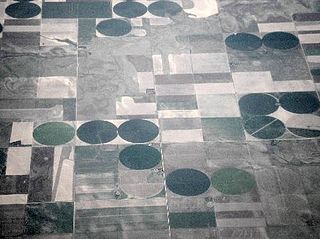
A farm is an area of land that is devoted primarily to agricultural processes with the primary objective of producing food and other crops; it is the basic facility in food production. The name is used for specialized units such as arable farms, vegetable farms, fruit farms, dairy, pig and poultry farms, and land used for the production of natural fiber, biofuel, and other commodities. It includes ranches, feedlots, orchards, plantations and estates, smallholdings, and hobby farms, and includes the farmhouse and agricultural buildings as well as the land. In modern times, the term has been extended so as to include such industrial operations as wind farms and fish farms, both of which can operate on land or at sea.

The British Agricultural Revolution, or Second Agricultural Revolution, was an unprecedented increase in agricultural production in Britain arising from increases in labor and land productivity between the mid-17th and late 19th centuries. Agricultural output grew faster than the population over the hundred-year period ending in 1770, and thereafter productivity remained among the highest in the world. This increase in the food supply contributed to the rapid growth of population in England and Wales, from 5.5 million in 1700 to over 9 million by 1801, though domestic production gave way increasingly to food imports in the 19th century as the population more than tripled to over 35 million.
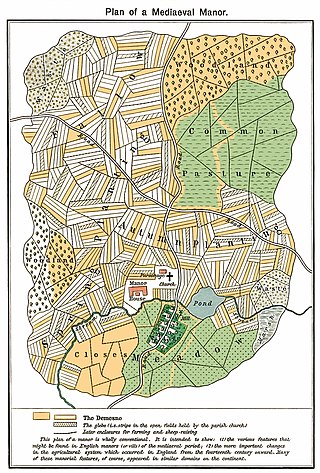
The open-field system was the prevalent agricultural system in much of Europe during the Middle Ages and lasted into the 20th century in Russia, Iran, and Turkey. Each manor or village had two or three large fields, usually several hundred acres each, which were divided into many narrow strips of land. The strips or selions were cultivated by peasants, often called tenants or serfs. The holdings of a manor also included woodland and pasture areas for common usage and fields belonging to the lord of the manor and the religious authorities, usually Roman Catholics in medieval Western Europe. The farmers customarily lived in separate houses in a nucleated village with a much larger manor house and church nearby. The open-field system necessitated co-operation among the residents of the manor.

Animal husbandry is the branch of agriculture concerned with animals that are raised for meat, fibre, milk, or other products. It includes day-to-day care, management, production, nutrition, selective breeding, and the raising of livestock. Husbandry has a long history, starting with the Neolithic Revolution when animals were first domesticated, from around 13,000 BC onwards, predating farming of the first crops. By the time of early civilisations such as ancient Egypt, cattle, sheep, goats, and pigs were being raised on farms.

Canada is one of the largest agricultural producers and exporters in the world. As with other developed nations, the proportion of the population agriculture employed and agricultural GDP as a percentage of the national GDP fell dramatically over the 20th century, but it remains an important element of the Canadian economy. A wide range of agriculture is practised in Canada, from sprawling wheat fields of the prairies to summer produce of the Okanagan valley. In the federal government, overview of Canadian agriculture is the responsibility of the Department of Agriculture and Agri-Food.
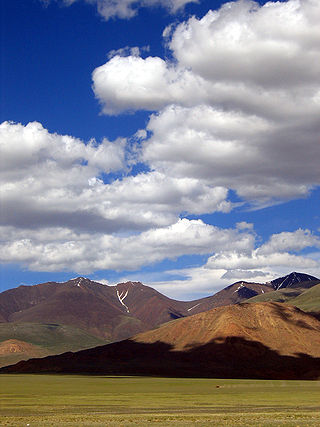
Agriculture in Mongolia constitutes over 10% of Mongolia's annual gross domestic product and employs one-third of the labor force. However, the high altitude, extreme fluctuation in temperature, long winters, and low precipitation provides limited potential for agricultural development. The growing season is only 95 – 110 days. Because of Mongolia's harsh climate, it is unsuited to most cultivation.
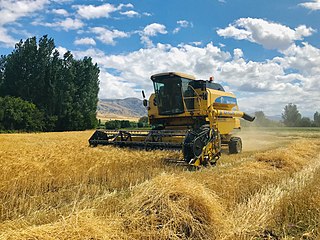
Agriculture is still an important sector of Turkey's economy, and the country is one of the world's top ten agricultural producers. Wheat, sugar beet, milk, poultry, cotton, vegetables and fruit are major products; and Turkey is the world's largest grower of hazelnuts, apricots, and oregano.

Agriculture in Ethiopia is the foundation of the country's economy, accounting for half of gross domestic product (GDP), 83.9% of exports, and 80% of total employment.
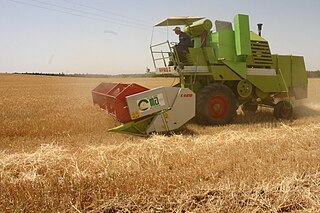
Agriculture in Algeria composes 25% of Algeria's economy and 12% of its GDP in 2010. Prior to Algeria’ colonization in 1830, nonindustrial agriculture provided sustenance for its population of approximately 2-3 million. Domestic agriculture production included wheat, barley, citrus fruits, dates, nuts, and olives. After 1830, colonizers introduced 2200 individual farms operated by private sectors. Colonial farmers continued to produce a variety of fruits, nuts, wheat, vegetables. Algeria became a large producer of wine during the late 19th century due to a crop epidemic that spread across France. Algeria's agriculture evolved after independence was achieved in 1962. The industry experienced multiple policy changes modernize and decry on food imports. Today, Algeria's agriculture industry continues to expand modern irrigation and size of cultivable land.

Agriculture in Scotland includes all land use for arable, horticultural or pastoral activity in Scotland, or around its coasts. The first permanent settlements and farming date from the Neolithic period, from around 6,000 years ago. From the beginning of the Bronze Age, about 2000 BCE, arable land spread at the expense of forest. From the Iron Age, beginning in the seventh century BCE, there was use of cultivation ridges and terraces. During the period of Roman occupation there was a reduction in agriculture and the early Middle Ages were a period of climate deterioration resulting in more unproductive land. Most farms had to produce a self-sufficient diet, supplemented by hunter-gathering. More oats and barley were grown, and cattle were the most important domesticated animal. From c. 1150 to 1300, the Medieval Warm Period allowed cultivation at greater heights and made land more productive. The system of infield and outfield agriculture may have been introduced with feudalism from the twelfth century. The rural economy boomed in the thirteenth century, but by the 1360s there was a severe falling off in incomes to be followed by a slow recovery in the fifteenth century.
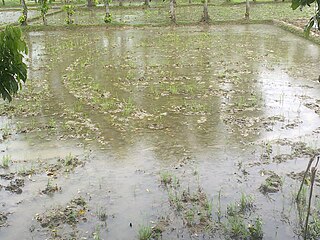
Agricultural land is typically land devoted to agriculture, the systematic and controlled use of other forms of life—particularly the rearing of livestock and production of crops—to produce food for humans. It is generally synonymous with both farmland or cropland, as well as pasture or rangeland.

Agriculture in the United Kingdom uses 69% of the country's land area, employs 1% of its workforce and contributes 0.5% of its gross value added. The UK currently produces about 60% of its domestic food consumption.

Agriculture in Jordan contributed substantially to the economy at the time of Jordan's independence, but it subsequently suffered a decades-long steady decline. In the early 1950s, agriculture constituted almost 40 percent of GNP; on the eve of the Six-Day War, it was 17 percent.
For centuries Iceland's main industries were fishing, fish processing and agriculture. In the 19th century, 70–80% of Icelanders lived by farming, but there has been a steady decline over the years and now that figure is less than 5% of the total population. It is expected that the number will continue to fall in the future. Only 1% of the total land area is under arable cultivation, confined almost exclusively to the peripheral lowland areas of the country.
Agriculture has historically been the primary industry of the English county of Cheshire. Dairy farming has predominated, and the county was particularly known for cheese-making.
Convertible husbandry, also known as alternate husbandry or up-and-down husbandry, is a method of farming whereby strips of arable farmland were temporarily converted into grass pasture, known as leys. These remained under grass for up to 10 years before being ploughed under again, while some eventually became permanent pasturage. It was a process used during the 16th century through the 19th century by "which a higher proportion of land was used to support increasing numbers of livestock in many parts of England." Its adoption was an important component of the British Agricultural Revolution.

A staple food, food staple, or simply staple, is a food that is eaten often and in such quantities that it constitutes a dominant portion of a standard diet for an individual or a population group, supplying a large fraction of energy needs and generally forming a significant proportion of the intake of other nutrients as well. For humans, a staple food of a specific society may be eaten as often as every day or every meal, and most people live on a diet based on just a small variety of food staples. Specific staples vary from place to place, but typically are inexpensive or readily available foods that supply one or more of the macronutrients and micronutrients needed for survival and health: carbohydrates, proteins, fats, minerals, and vitamins. Typical examples include grains, seeds, nuts and root vegetables. Among them, cereals, legumes and tubers account for about 90% of the world's food calorie intake.

Agriculture in Wales has in the past been a major part of the economy of Wales, a largely rural country which is part of the United Kingdom. Wales is mountainous and has a mild, wet climate. This results in only a small proportion of the land area being suitable for arable cropping, but grass for the grazing of livestock is present in abundance. As a proportion of the national economy, agriculture is now much less important; a high proportion of the population now live in the towns and cities in the south of the country and tourism has become an important form of income in the countryside and on the coast. Arable cropping is limited to the flatter parts and elsewhere dairying and livestock farming predominate.

Agriculture in the Middle Ages describes the farming practices, crops, technology, and agricultural society and economy of Europe from the fall of the Western Roman Empire in 476 to approximately 1500. The Middle Ages are sometimes called the Medieval Age or Period. The Middle Ages are also divided into the Early, High, and Late Middle Ages. The early modern period followed the Middle Ages.

Agriculture in Ireland began during the neolithic era, when inhabitants of the island began to practice animal husbandry and farming grains. Principal crops grown during the neolithic era included barley and wheat.






















